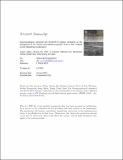Geochronological, elemental and Sr-Nd-Hf-O isotopic constraints on the petrogenesis of the Triassic post-collisional granitic rocks in NW Thailand and its Paleotethyan implications
Abstract
New U-Pb geochronological, petrologic, elemental and Sr-Nd-Hf-O isotopic data for the granites from the Inthanon and Sukhothai zones in NW Thailand in conjunction with correlations with SW China are presented to constrain the age and position of the Paleotethys Ocean in this region and the associated assembly of Southeast Asia. The geochronological data show that the granitic rocks in the Inthanon and Sukhothai zones, herein named Group 1 and Group 2 granites, respectively, yield similar crystallization ages of 230-200 Ma. Group 1 samples are characterized by monzogranite and granite with I- and S-type geochemical affinity and Group 2 samples by I-type monzogranite and granodiorite. They have generally similar chondrite-normalized REE and PM- normalized multi-element patterns but distinct Sr-Nd-Hf-O isotopic compositions. Group 1 samples have slightly higher initial 87Sr/86Sr ratios (0.7111- 0.7293) but lower εNd(t) values (-11.1 ~ -14.1) than those of Group 2 samples (87Sr/86Sr(i)=0.7073-0.7278 and εNd(t)=-8.3 ~ -11.0). Group 1 samples show the lower εHf(t) values (-5.4 ~ -18.2), older TDM (1.62-2.40 Ga) and higher δ18O values (+ 7.95-+9.94) than those of Group 2 samples (εHf(t) of -11.1-+4.80, TDM of 0.96-1.95 Ga and δ18O of + 4.95 ~+7.98) for the Triassic crystallization zircons. These geochemical signatures are similar to the Kwangsian and Indosinian granites in the South China and Indochina blocks but distinct from those of the Gangdese I-type granite and Sibumasu Paleozoic granite. Our data suggest that Group 1 samples mainly originated from the early Paleozoic supracrustal rocks containing metapelite and metavolcanic components, which had previously experienced the surface weathering. Group 2 samples were derived from a hybridized source of an old metamorphic and a newly underplated mafic component. Synthesis of our data with available regional observations indicate that the Inthanon zone represents the main suture zone of the eastern Paleotethyan Ocean in NW Thailand and links with the Changning-Menglian suture zone in SW Yunnan (SW China). In NW Thailand, a switch from the eastward subduction of the Paleotethyan oceanic plate to the collision of the Sibumasu with Indochina blocks occurred at ~ 237 Ma, and syn- and post-collisional time being at ~ 237-230 Ma and ~ 200-230 Ma, respectively. The late Triassic granites in the Inthanon and Sukhothai zones are representative of the post-collisional magmatic products.
Citation
Wang , Y , He , H , Cawood , P A , Fan , W , Srithai , B , Feng , Q , Zhang , Y & Qian , X 2016 , ' Geochronological, elemental and Sr-Nd-Hf-O isotopic constraints on the petrogenesis of the Triassic post-collisional granitic rocks in NW Thailand and its Paleotethyan implications ' , Lithos , vol. 226-267 , pp. 264-286 . https://doi.org/10.1016/j.lithos.2016.09.012
Publication
Lithos
Status
Peer reviewed
ISSN
0024-4937Type
Journal article
Description
This study was jointly funded by the National Science Foundation of China (41190073), National Basic Research Program of China (2014CB440901 and 2016YFC0600303) and the Fundamental Research Funds for the Central Universities to SYSU.Collections
Items in the St Andrews Research Repository are protected by copyright, with all rights reserved, unless otherwise indicated.

